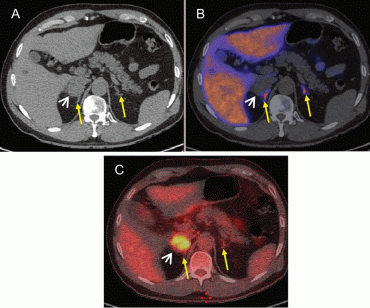SFEEU2017 National Clinical Cases Poster Presentations (26 abstracts)
A novel approach to the investigation of an atypical adrenal lesion: 11C-metomidate PET-CT combined with 18F-FDG PET-CT in a rare case of adrenal Hodgkin’s lymphoma
Andrew S Powlson 1 , Olympia Koulouri 1 , Heok K Cheow 2 , Ashley Shaw 3 , Neville V Jamieson 4 , George Follows 5 & Mark Gurnell 1
1Metabolic Research Laboratories, Wellcome Trust-MRC Institute of Metabolic Science, University of Cambridge and Addenbrooke’s Hospital, Cambridge, UK; 2Department of Nuclear Medicine, Addenbrooke’s Hospital, Cambridge, UK; 3Department of Radiology, Addenbrooke’s Hospital, Cambridge, UK; 4Department of Hepatobiliary Surgery, Addenbrooke’s Hospital, Cambridge, UK; 5Department of Haematology, Addenbrooke’s Hospital, Cambridge, UK.
Case history: A 66-year-old man presented with a 1 month history of a productive cough, in the context of a 20 pack-year smoking history. CT chest revealed minor bronchiectasis and an incidental 3 cm right adrenal lesion. He was referred to the endocrine clinic for further evaluation. On questioning, he reported no symptoms suggestive of adrenal hormone hypersecretion and, aside from a short history (<1 month) of sweating episodes at night, he described no other constitutional symptoms. Physical examination was unremarkable, with no stigmata of endocrine disease.
Investigations: Routine biochemistry, including renal and liver function and full blood count, returned normal results. Plasma metanephrines were not elevated, and the plasma aldosterone: renin ratio was unremarkable. Serum cortisol suppressed to 27 nmol/l following a 1 mg overnight dexamethasone suppression test and plasma ACTH was not suppressed. DHEAS was normal. Further imaging was arranged to characterise his adrenal lesion.
Results and treatment: The adrenal nodule was considered indeterminate on the original CT chest, with Hounsfield units (HU) of 45. A dedicated adrenal scan demonstrated a 45 mm irregular right adrenal lesion, indicating a 50% increase in size in just 8 weeks (Panel A, white arrowhead denotes lesion, yellow arrows indicate normal adrenal tissue). Triple phase studies revealed an attenuation value of 40HU at baseline, 62HU at 1 min following contrast and 52HU on 10 min delayed imaging (washout 45%), suggesting the lesion was not a benign adenoma. No separate primary tumour was identified on staging CT. 11C-metomidate, which binds CYP11B1 and B2 in adrenocortical tissue, showed no uptake by the mass, but demonstrated normal tracer distribution within the left adrenal gland and preserved uptake in remaining normal right adrenal tissue adjacent to the mass (B). In contrast, 18F-FDG-PET revealed high tracer uptake in the right adrenal mass and in 6 mm retrocaval and 11 mm aortocaval nodes, but low uptake at sites corresponding to the normal left adrenal and residual remaining normal right adrenal gland (C). An open adrenalectomy was performed and a 75×50×35 mm right adrenal lesion was resected. Histology and immunohistochemistry confirmed a compressed normal adrenal gland surrounded by, and partially infiltrated by, a firm white lesion comprising predominantly CD4 and CD8 positive T lymphocytes, with larger atypical cells staining for CD30, PAX5 and EBR, and negative for ALK and CD45. These appearances are characteristic for classical Hodgkin’s lymphoma (HL - nodular sclerosing type). The FDG-avid retrocaval nodes also demonstrated HL.
Conclusions and points for discussion:
This unusual case provides the opportunity to discuss:
i) the approach to investigating an adrenal incidentaloma,
ii) demonstration of the potential utility of the novel paradigm of combining 11C-metomidate and 18F-FDG PET-CT to distinguish between primary adrenal tumours and other benign or malignant lesions and
iii) one of the first descriptions of primary adrenal Hogdkin’s lymphoma.

 }
}



